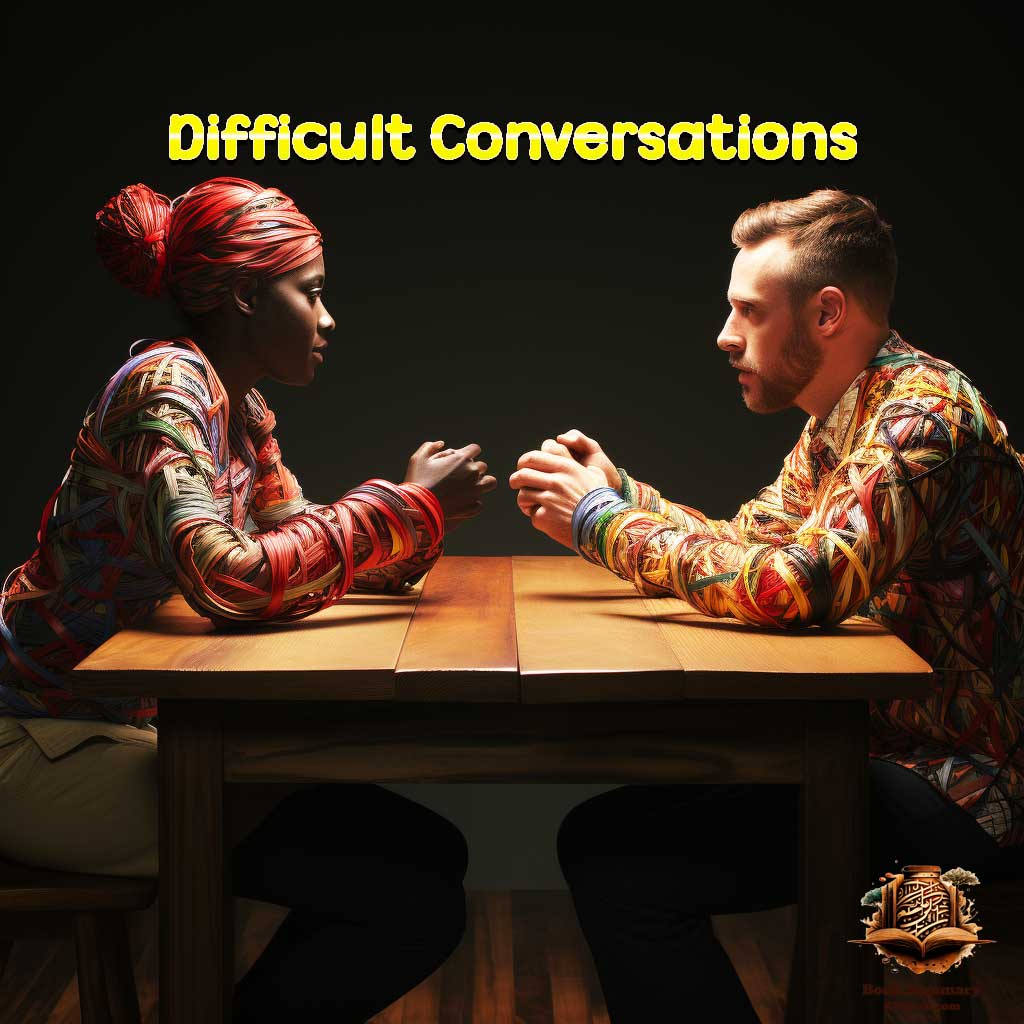Difficult Conversations: How to Discuss What Matters Most Book Summary

In our contemporary world, where cultures intertwine and ideas intersect, difficult conversations become an integral part of our daily lives. Whether it’s in the workplace, within the family, or in social relationships, we encounter situations that require skill and precision in both expressing ourselves and listening. “Difficult Conversations: How to Discuss What Matters Most” is a guide that paves the way to a deeper understanding of these conversations.
The book, authored by experts in the fields of negotiation and communication, namely Douglas Stone, Bruce Patton, and Sheila Heen, lays down a new approach to understanding and tackling conversations that might be laden with challenges and intricacies. It categorizes difficult conversations into three main levels: the “What Happened?” conversation, the feelings conversation, and finally, the identity conversation.
In “Difficult Conversations,” readers won’t just find theoretical guidelines; instead, they will encounter real-life examples and practical exercises to apply what they’ve learned to their day-to-day contexts. Hence, this book is more than just a theoretical piece; it’s a practical tool aimed at enhancing one’s communication skills and understanding of others.
If you’re looking to improve your communication abilities, understand the challenges behind some of your conversations, or even if you’re on a personal development journey, “Difficult Conversations” will be the guide to accompany you through this voyage.
How Do “Difficult Conversations” Unfold the Layers of Human Interaction?
Navigating the maze of human communication often feels overwhelming, especially when stakes are high, opinions vary, or emotions run strong. The book “Difficult Conversations: How to Discuss What Matters Most” provides a lens through which we can dissect these multifaceted dialogues into more comprehensible segments. One of the core insights of this insightful guide revolves around three pivotal conversations.
The “What Happened?” Conversation:
This level unravels the myriad perceptions and interpretations surrounding a particular event or discussion. It’s essential to understand that everyone involved may view situations through their unique prisms, influenced by their experiences, beliefs, and values. Therefore, it’s seldom about the objective truth but more about the myriad perspectives that converge during these discussions. Recognizing this multiplicity can often be the first step toward productive dialogue, as it promotes mutual respect and curtails the urge to lay blame.
The Feelings Conversation:
Emotions aren’t just byproducts of conversations; they often form their very backbone. When discussing matters of importance, emotions can either pave the way for mutual understanding or create barriers. By giving emotions their due acknowledgment, we provide a space for genuine expression and avoid the pitfalls of suppressed feelings, which can lead to escalated tensions or unresolved issues. An integral part of mastering difficult conversations lies in understanding, articulating, and addressing these emotions constructively.
The Identity Conversation:
Our discussions, especially the challenging ones, often strike chords related to our personal identity and self-worth. This layer of conversation delves into the questions: What does this situation say about me as a person? How does it impact how I view myself? For many, the outcomes of difficult discussions can be a reflection of their competencies, values, or characteristics. It’s crucial to differentiate between what’s being said in the conversation and the larger implications it might have on one’s self-worth. By doing so, it’s possible to steer the conversation toward more objective ground, avoiding the quicksand of personal insecurities or defensiveness.
In sum, “Difficult Conversations” offers more than just strategies; it provides a roadmap to the human psyche during challenging interactions. By understanding these three foundational conversations, individuals and professionals alike can tread the often tumultuous waters of difficult discussions with more confidence, empathy, and clarity.
Our Facebook Page – Book Summary
How Does “Difficult Conversations” Advocate for a Paradigm Shift in our Conversational Approach?
In the labyrinth of interpersonal interactions, understanding how to communicate effectively is crucial. “Difficult Conversations” is a seminal guide that sheds light on enhancing our approach to challenging dialogues, emphasizing a significant paradigm shift from merely delivering a message to actively learning from the conversation.
Embracing Genuine Curiosity:
At the heart of any effective conversation is genuine curiosity. Instead of entering a dialogue with preconceived notions or a fixed agenda, “Difficult Conversations” encourages readers to approach situations with an open mind. This involves actively seeking to understand the other person’s perspective, asking questions, and truly listening. This openness not only facilitates better understanding but also fosters trust and mutual respect.
Acknowledging and Clarifying Intentions:
Misunderstandings often arise from unclear intentions or misinterpretations of one’s motives. The book stresses the importance of being transparent about one’s intentions in a conversation. By acknowledging and clarifying our objectives and reasons at the outset, we can mitigate potential conflicts and ensure that the conversation stays on a constructive path. It’s not just about conveying our intentions but also understanding the intentions of others, which can lead to more meaningful and fruitful interactions.
Managing Internal Narratives and Reactions:
Every individual brings to a conversation a set of internal narratives shaped by past experiences, beliefs, and biases. These internal stories can significantly influence our reactions and perceptions during a discussion. “Difficult Conversations” delves into the intricacies of recognizing and managing these internal dialogues. By being self-aware and understanding the source of our reactions, we can better regulate our emotions, prevent knee-jerk responses, and maintain a balanced perspective throughout the dialogue.
In essence, “Difficult Conversations” offers a transformative approach to the way we engage in dialogues, especially challenging ones. By shifting our focus from mere message delivery to active learning and understanding, we can navigate the complexities of interpersonal interactions more effectively and foster deeper connections with those around us.
Life Sciences & Medicine – Book Summary (khkitab.com)
How Does “Difficult Conversations” Shift the Perspective from Blame to Shared Contribution in Conflicts?
In the vast landscape of interpersonal communication, one of the most treacherous terrains is where blame is cast and fingers are pointed. “Difficult Conversations” brings a fresh, transformative perspective to this challenge by emphasizing the concept of shared contribution over blame.
Redefining Accountability:
The traditional approach to conflict often seeks to identify a culprit, a singular point of failure. However, “Difficult Conversations” champions the idea that in most situations, all parties involved have contributed in some way to the predicament. By acknowledging each person’s role, we shift from a punitive mindset to a collaborative one. This fosters a more conducive environment for constructive dialogue and problem-solving.
The Power of Shared Experiences:
When conflicts are viewed as shared experiences, they transform from battlegrounds into learning opportunities. It creates a space where individuals can reflect on their actions, understand their impacts, and collectively brainstorm solutions. Recognizing that everyone has played a part, however small, encourages empathy and mutual understanding.
Moving Beyond the Blame Game:
Blame is a defense mechanism, often shielding us from introspection and accountability. By shifting the focus to shared contribution, “Difficult Conversations” guides individuals to move beyond this unproductive cycle. Instead of getting entrenched in a loop of accusations, the emphasis is on understanding the broader picture, where multiple factors and actions intersect to create the situation at hand.
The Path to Constructive Outcomes:
By prioritizing contribution over blame, the book paves the way for more positive outcomes. Solutions are more holistic, as they take into account the entire spectrum of actions and reactions from all involved. Moreover, it reduces the emotional toll of the conversation, making space for healing, growth, and stronger relationships.
In conclusion, “Difficult Conversations” offers an invaluable lens to view conflicts not as blame games but as collective experiences that offer growth and understanding. This shift in perspective is pivotal for anyone looking to enhance their communication skills and build more meaningful, resilient relationships.
How Does “Difficult Conversations” Emphasize the Essence of Active Listening in Effective Communication?
The art of conversation is not merely in speaking but significantly rooted in the act of listening. “Difficult Conversations” accentuates this often-underestimated skill, championing the significance of active listening in forging meaningful and effective dialogues.
Beyond Passive Hearing:
Active listening transcends the passive act of merely hearing words. It entails an engaged effort to genuinely understand and internalize the content of what is being said. “Difficult Conversations” delineates the difference, shedding light on the profound impact of truly tuning in, as opposed to simply processing sounds.
Decoding the Unspoken:
Often, the essence of a message lies not just in the spoken words but in the unspoken emotions, body language, and underlying intentions. Active listening, as described in “Difficult Conversations”, involves being attuned to these subtle cues, offering a deeper comprehension of the entire message being conveyed.
Empathy and Validation:
By actively listening, we signal to the speaker that their thoughts and feelings are valid and acknowledged. This engenders a sense of trust and empathy, making the conversation ground more conducive for open dialogue. “Difficult Conversations” emphasizes how this aspect of active listening can be transformative in resolving conflicts and bridging divides.
The Power of Presence:
In an age of constant distractions, being fully present in a conversation has become a rarity. The book underscores the importance of dedicating one’s undivided attention to the speaker, resisting the urge to formulate responses or get lost in personal thoughts. This heightened level of presence not only enhances understanding but also strengthens the bond between the conversationalists.
In essence, “Difficult Conversations” champions active listening as a cornerstone of impactful communication. By genuinely hearing and understanding the other person’s point of view, we pave the way for richer, more constructive dialogues, fostering connections that transcend mere words.
How Does “Difficult Conversations” Guide Individuals to Manage Emotions Effectively During Challenging Dialogues?
Navigating the waters of emotionally charged conversations can be daunting. “Difficult Conversations” serves as a compass, providing invaluable insights and strategies for individuals to recognize, validate, and express their emotions constructively during intense interactions.
Emotional Awareness:
One of the foundational teachings of “Difficult Conversations” is the imperative of self-awareness. Before we can manage our emotions effectively, we must first be attuned to them. By understanding our triggers and the root causes of our emotional responses, we equip ourselves with the knowledge to prevent unnecessary escalations and knee-jerk reactions.
Validation as a Tool:
Emotions, regardless of how intense or mild, deserve validation. By acknowledging and validating our feelings and those of others, we pave the way for more empathetic and understanding dialogues. “Difficult Conversations” underscores the importance of not brushing aside emotions, but rather seeing them as crucial data points in the conversation landscape.
Constructive Expression:
Merely recognizing and validating emotions isn’t enough; it’s how we choose to express them that determines the trajectory of the dialogue. The book offers practical strategies for constructive emotional expression, such as using “I” statements to express feelings without laying blame, and employing active listening to ensure mutual understanding.
Navigating Emotional Minefields:
Challenging conversations can sometimes resemble minefields of emotions, where one misstep can lead to an explosion. “Difficult Conversations” provides a roadmap for navigating these terrains by suggesting techniques like pausing before responding, reframing negative emotions into positive actionable feedback, and seeking clarifications rather than making assumptions.
Maintaining Emotional Equilibrium:
Stability is key. The book stresses the importance of maintaining an emotional equilibrium, suggesting mindfulness practices and grounding techniques to ensure that one remains centered and composed, even when the conversation heats up.
In conclusion, “Difficult Conversations” offers a holistic approach to handling emotions during challenging dialogues. By mastering the art of managing difficult emotions, individuals can ensure that their conversations are productive, respectful, and solution-oriented, regardless of the emotional intensity involved.
How Does “Difficult Conversations” Illuminate Techniques to Steer Conversations Constructively?
Effective communication goes beyond mere words; it’s an art that involves understanding, empathy, and strategy. “Difficult Conversations” delves into the nuances of this art, equipping its readers with practical tools to ensure that dialogues remain positive and productive, even under challenging circumstances.
Tackling Assumptions:
One of the key hindrances in any dialogue is making assumptions. “Difficult Conversations” advocates for an open-minded approach where participants seek clarity rather than making prejudgments. By inquiring instead of assuming, we pave the way for mutual understanding and reduce the risk of misunderstandings that can derail a conversation.
Maintaining Composure:
An unspoken rule in managing challenging discussions is staying grounded and calm. The book emphasizes the importance of emotional intelligence and self-awareness in keeping oneself centered. By not allowing external triggers to cloud our judgment, we can navigate the conversation with clear-headedness, ensuring that it remains on a constructive path.
Discovering Common Ground:
At the heart of many conflicts lies shared interests or concerns that often go unrecognized. “Difficult Conversations” highlights the significance of seeking common ground. By identifying shared objectives or mutual concerns, participants can transition from being adversaries to collaborators, working towards a shared solution.
Holistic Approach to Communication:
Effective dialogue is more than just the exchange of words. It’s about understanding the sentiments behind those words, acknowledging different perspectives, and striving for a mutual understanding. By adhering to the guidelines and insights provided by “Difficult Conversations”, individuals can transcend common communication pitfalls and steer conversations in a direction that is both constructive and resolution-oriented.
In essence, “Difficult Conversations” serves as a masterclass in navigating the intricate maze of human interactions, ensuring that dialogues, regardless of their complexity, are steered towards positive outcomes and mutual understanding.
What Are the Potential Repercussions of Not Addressing or Mishandling Difficult Conversations as Highlighted in “Difficult Conversations”?
Engaging in meaningful dialogue, especially when the subject matter is challenging or sensitive, is crucial for healthy relationships and effective organizations. “Difficult Conversations” offers a deep dive into the potential repercussions of either avoiding or mishandling these pivotal discussions, emphasizing the long-term impacts that can reverberate across personal and professional realms.
Strained Relationships:
Avoiding or poorly managing difficult conversations can lead to mistrust and resentment. Over time, these feelings can accumulate, eroding the foundation of trust that is essential for any healthy relationship, whether it’s with family, friends, or colleagues.
Lost Opportunities:
Proactively addressing challenging topics can pave the way for growth, innovation, and improved collaboration. By sidestepping these discussions or handling them ineffectively, individuals and organizations might miss out on invaluable opportunities for advancement and development.
Decreased Morale and Productivity:
In professional settings, mishandling crucial conversations can lead to a decline in morale. Employees might feel unheard, undervalued, or insecure about their roles. This, in turn, can result in decreased productivity, high turnover rates, and a stifled organizational culture.
Emotional Toll:
On a personal level, avoiding or mismanaging tough conversations can lead to an emotional toll. This might manifest as stress, anxiety, or feelings of guilt and regret. Over time, such emotional burdens can impact one’s overall well-being and mental health.
Escalation of Issues:
Many problems or misunderstandings can be nipped in the bud through open dialogue. However, if left unaddressed, they can escalate, transforming minor disagreements into significant conflicts or disputes.
In essence, “Difficult Conversations” underlines the importance of confronting and adeptly handling challenging dialogues. By doing so, individuals and organizations can preemptively address potential issues, foster understanding, and lay the groundwork for stronger, more fruitful relationships and endeavors. Avoidance or mismanagement, on the other hand, can lead to a cascade of negative consequences that are far-reaching and, at times, irreversible.
How Does “Difficult Conversations” Emphasize the Transformative Role of Genuine Apologies in Repairing Relationships?
The dynamics of human interactions are intricate, and often, misunderstandings or missteps can cause rifts in relationships. The book “Difficult Conversations” provides a profound insight into the pivotal role of genuine apologies in healing and restoration. Delving into this theme, one discovers the undeniable power of acknowledgment and sincere remorse in rebuilding trust and mending bonds.
Acknowledgment – The First Step:
Before an apology can even begin to have its transformative effect, the act of acknowledgment is crucial. Recognizing and owning up to one’s mistakes is a testament to one’s maturity and sincerity. “Difficult Conversations” accentuates how acknowledging an error can pave the way for meaningful reconciliation, as it shows the aggrieved party that their feelings and perceptions are valid.
The Anatomy of a Genuine Apology:
A genuine apology transcends mere words. It encompasses genuine remorse, understanding the impact of one’s actions, and a commitment to ensuring the mistake isn’t repeated. The book emphasizes that a superficial or forced apology can sometimes exacerbate the situation, underscoring the importance of authenticity in the process.
Restorative Power:
When delivered with authenticity and empathy, an apology can be a potent tool for healing. It not only provides closure to the aggrieved party but also reaffirms mutual respect and understanding in the relationship. “Difficult Conversations” showcases various anecdotes and real-life scenarios where genuine apologies have bridged seemingly insurmountable gaps.
Building Trust Through Vulnerability:
Apologizing requires vulnerability. By admitting one’s mistakes and seeking forgiveness, individuals display a level of openness and humility that can be instrumental in rebuilding trust. The book underscores the idea that, in relationships, vulnerability can be a strength, laying the foundation for deeper connections and mutual respect.
In conclusion, “Difficult Conversations” paints a vivid picture of the transformative power of genuine apologies in relationships. By delving into the nuances of effective apologies – from acknowledgment to the display of genuine remorse – the book offers invaluable insights into mending and strengthening relationships, emphasizing that at the heart of any genuine apology lies the earnest desire to heal and reconnect.


